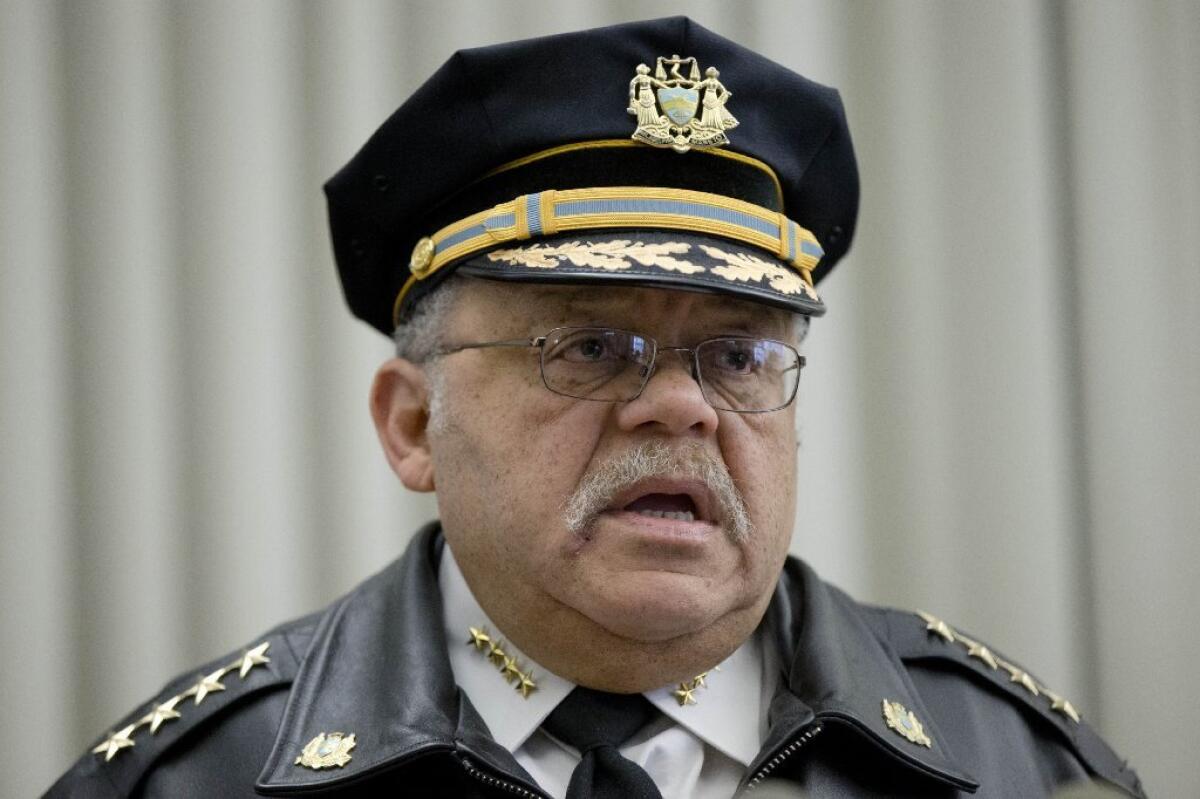Philadelphia Police Department needs reforms, Justice Department finds

- Share via
A federal review of the Philadelphia Police Department’s use-of-force policy found shortfalls in the way the agency investigates fatal police shootings as well as inadequate training that has led to “significant strife” between officers and the residents they are sworn to protect.
The findings, compiled by the Community Oriented Policing Services division of the Department of Justice, were made public Monday, more than a year after Philadelphia Police Commissioner Charles Ramsey requested federal assistance to deal with a surge of fatal police shootings in 2013.
“The department has much work to do in the months and years ahead. Our assessment uncovered policy, training and operational deficiencies in addition to an undercurrent of significant strife between the community and department,” the Justice Department report says.
Philadelphia police officers do not receive “regular, consistent” training in the department’s policy on deadly force, and the department does not make it easy for officers to use stun guns, leaving them with fewer options to avoid using deadly force, the federal agency found.
Ramsey asked for the federal review in 2013 when he noticed officer-involved shootings were increasing even though violent crime and assaults against officers in the city were on the decline.
From 2007 through 2014, there were 394 officer-involved shootings in the city, according to the report. In recent years, the number of such shootings decreased from 58 in 2012 to 28 last year.
The review found that deficiencies in the way the Philadelphia police handle internal probes of officer-involved shootings and alleged officer misconduct leave “segments of the community feeling disenfranchised and distrustful of the police department.”
That distrust might be exacerbated by apparent racial disparities in officer-involved shootings. The report says 59% of the officers involved in shootings from 2007 through 2014 were white, while 81% of those struck by police gunfire were black.
In that same eight-year span, Philadelphia police shot 59 unarmed suspects, roughly 16% of the total number of people they shot. Forty-five of those unarmed suspects were black, the report found.
“These racial disparities have created a deep mistrust of law enforcement in communities of color,” Reggie Shuford, executive director of the Pennsylvania chapter of the American Civil Liberties Union, said in a statement. “The police department must begin to repair this relationship by emphasizing de-escalation and mutual respect in their interactions rather than relying on force.”
The federal review also found that officers involved in those shootings from 2007 through 2014 were relatively inaccurate. Officers hit their targets just 18% of the time, according to the report, and accuracy plummeted as the number of shots in an incident increased. Officers who fired only once during a clash with a suspect hit their intended targets about half of the time, the report says.
Federal investigators suggested the department issue stun guns to all patrol officers as a way to decrease officer-involved shootings.
The Philadelphia Police Department does not record interviews with witnesses to officer-involved shootings, or interviews with the officers themselves, meaning the only records of those conversations are typed notes, according to the report. In addition, the department’s internal affairs investigators generally wait for the city district attorney’s office to finish its own review of each officer-involved shooting before conducting their own probe, meaning an officer who fires his weapon may not be interviewed by an internal affairs detective for months.
Ramsey said he was pleased with the results of the review, and acknowledged the department has a long road ahead to implement the suggested reforms.
“While we have the immense task of keeping our officers safe, we also have the responsibility of being as transparent as possible to our citizens. It’s about a balanced approach, and we are committed to the task,” Ramsey said in a statement.
While Ferguson, Mo., and New York’s Staten Island -- sites of the killings of Michael Brown and Eric Garner, respectively -- have been seen as flash points for the national conversation on race and police policy, Philadelphia also has experienced troubling incidents that have raised tensions in the community.
The Philadelphia City Council elected to decriminalize marijuana last year after a review of police arrest records found 83% of those arrested for simple marijuana possession were black, leading some to question whether officers were targeting suspects along racial lines.
City residents were also roiled last week when Philadelphia Dist. Atty. Seth Williams declined to file criminal charges against the officers involved in a shooting that left Brandon Tate-Brown dead after a motor-vehicle stop in December. Both officers said Tate-Brown was reaching for a weapon, and the district attorney’s office said a gun was recovered at the scene.
Tate-Brown’s killing set off some protests in the city, including a demonstration at a police community board meeting, according to a report in the Philadelphia Inquirer.
Follow @JamesQueallyLAT for breaking news
More to Read
Sign up for Essential California
The most important California stories and recommendations in your inbox every morning.
You may occasionally receive promotional content from the Los Angeles Times.











